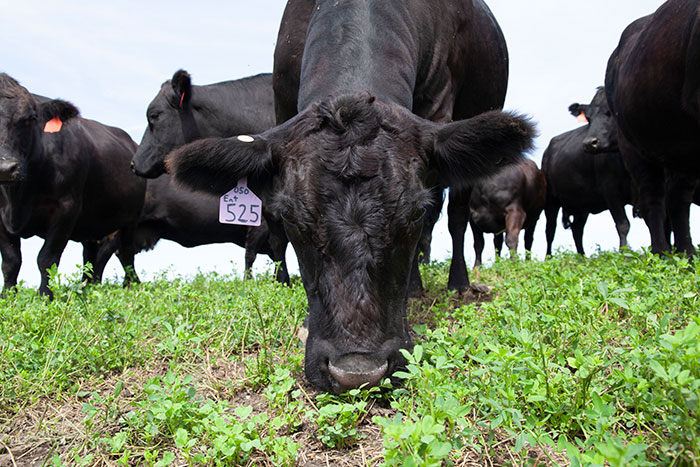
Many livestock producers view the practice of grazing alfalfa as a form of Russian roulette. The differences of opinion among this group usually comes down to how many of the chambers they think are occupied by a bullet.
A recent blog post from Canada’s Beef Cattle Research Council (BFRC) addressed this contentious topic based on both research findings and farmer experience. The conclusion was to respect the practice of grazing alfalfa but try not to fear it.
The potential benefits of grazing alfalfa are well documented and include exceptional livestock weight gains, nitrogen contributions to the soil, a hedge against poor forage production during dry conditions, and a means to enhance biodiversity when mixed with grass.
The fear factor, which is understandable, is all about the risk of bloat.
Blends have least risk
Though grazing pure alfalfa stands has been made to work, most beef producers may be more interested in blending alfalfa with grasses.
“We’ve looked at alfalfa in several different grazing studies over the years, most often used in a binary mix with grasses,” says Bart Lardner, a former research scientist at the Western Beef Development Centre, now a professor in the Department of Animal and Poultry Science at the University of Saskatchewan. “The alfalfa component produces several benefits. Our industry has lost a lot of money over the years by avoiding alfalfa, partly due to unwarranted fear,” he adds.
Lardner notes that timing is one of the keys for reducing bloat risk. He says that in pastures that contain a high percentage of alfalfa, it’s prudent to wait until the legume reaches at least the bud stage. He also suggests not introducing cattle to alfalfa pastures when a heavy dew exists or while it is raining.
“As plants mature and develop more fiber, the risk of bloat greatly decreases as the stand reaches 30 to 40 percent flower stage,” Larder notes. “And using alfalfa in a pasture’s forage mix that includes more fibrous grasses also provides cattle with a wider feed selection than just straight alfalfa.”
Alfalfa’s big advantage comes in the form of animal performance. For this reason, it is an excellent choice when grazing cow-calf pairs or for stockers. Studies have shown that a 50/50 mixture of alfalfa and grasses can generally produce 1.5 to over 2 pounds of gain per day. Those are also the kind of gains needed in successful grass-fed beef operations.
A drought buster
Another important aspect of alfalfa is its ability to produce when most other species have succumbed to dry growing conditions during the mid- and late-summer seasons.
Lardner references a current three-year study in southern Saskatchewan where they looked at including alfalfa in a pasture mix to help fill that late-summer and early-fall period when grass is slowed due to dry growing conditions. “Alfalfa, with deeper tap roots, can go down and reach the moisture and still be fairly productive,” Lardner explains. “We are still analyzing the numbers on this project, but we are happy with the results from the first two years. With good performance on the alfalfa it may have a role in carrying pastures and cattle through that late-summer period.”
For producers wishing to give alfalfa a try in their grazing operations, here are some of the recommendations that concluded the BCRC blog post:
- Never turn hungry livestock into a pasture containing a high proportion of alfalfa.
- Fill animals with dry hay or grass pasture before beginning to graze high-bloat potential pastures.
- Avoid turning animals onto fresh, high-bloat potential pasture that is moist with dew, rain, or irrigation water. Both rate of intake and initial rate of digestion are higher from moist plants, causing more rapid initial digestion.
- Never allow animals grazing alfalfa pasture to get so hungry that they consume too much in one feeding. Always have sufficient feed available.
- Make paddock rotations mid-day or later; this is when the forage is drier and plant carbohydrate concentrations are higher.
- Avoid dramatic changes in forage quality when rotating from paddock to paddock by leaving adequate residue.
- Observe livestock closely the first several days and remove any chronic-bloating animals.
- Avoid grazing legumes before they begin to bloom. Make closer observations for bloat when many plants are at a younger growth stage.
- Manage grazing to encourage livestock to consume low or nonbloating plants and plant parts such as an alfalfa/grass forage blend. For example, use daily strip grazing or use high stock density in multiple paddock systems rather than continuous stocking.
- Once grazing begins, don’t remove animals from pasture or make frequent, major changes in the type of pasture being grazed unless animals have greatly distended rumens. Mild bloat is common on high bloat-potential pastures. Frequent diet changes prevent rumen microbes and animals from adapting to bloat pastures.
- Be extra observant for cattle bloat when alfalfa shows a rapid flush of growth such as during cloudy, wet periods in the spring and after a plant stress event such as hail or drought.
- Delay grazing alfalfa for three to five days after freeze damage.
- Talk to your veterinarian about the advisability of using a bloat-prevention product.

